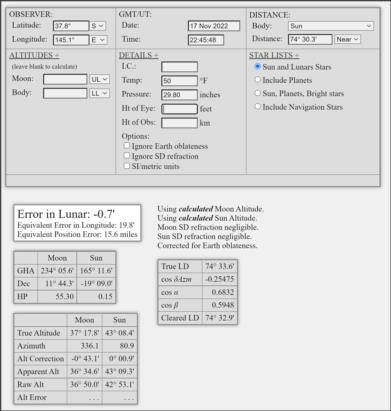
NavList:
A Community Devoted to the Preservation and Practice of Celestial Navigation and Other Methods of Traditional Wayfinding
From: Frank Reed
Date: 2022 Nov 17, 22:20 -0800
David M:
"the sky has been cloudy"
Annoying, isn't it? Last night here we had really impressive clear skies except for the clouds. Sounds like a joke, but it's not. There were significant low level clouds, but between the gaps, the transparency was excellent, and I could see down to magnitude 5.5 or better (which is good for semi-rural light pollution levels). But those darn low clouds!
I can't be sure what you entered in my web app for clearing lunars, but when I entered your data, I get an exact match to your result from the Stark tables, 74° 32.9' (see attached image), which I would expect. And did you try clearing by Thomson's tables?? There's a reason that we focused on them in the workshop. And there's a reason why those tables were included in the Lunars Guidebook for the class, right? :)
Your error of -0.7 minutes of arc is just fine for a first trial. Were your altitudes observed or calculated? I'm guessing they're calculated since they seem to be very close to the Sun and Moon "center" altitudes from my web app. How did you generate them? There's no provision to enter "center" altitudes in my web app. Maybe that's why your clearing result seems to be different. Try leaving the altitudes blank. Also, if you did generate your altitudes by calculation, be aware that a tenth of a degree rounding precision in the "AP" is equivalent to +/-3' in the computed altitudes. That's usually fine for lunars, of course.
You didn't tell us anything about your sextant. Is it a decent metal sextant? What is the magnification of the scope? How recent was your index error determination, and how did you measure it? And yes, averaging four or five LDs will typically reduce random error by a factor of two. It's easy enough to do several in a row like that once you have the instrument lined up for a single lunar.
Frank Reed







